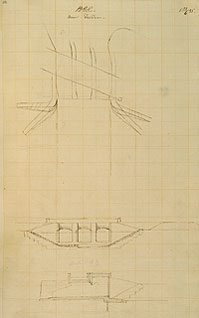


Brunel sketch of feeder sluice at Bristol
docks (University of Bristol)


In
1832, his professional link to the city was strengthened when, at the
request of the Bristol Docks Company, he submitted a report on improving
the flow of water and stability of the banks in the Floating Harbour.
He would be involved with the docks for the next 15 years. His contributions
included a dredging and sluicing system, an enlarged and improved entrance
lock, a tubular wrought iron footbridge and the engine house for the Black
Rock water pumping station.
In the long term, Bristol proved unable to compete with ports that could
provide room for large ocean-going vessels. Writing on the history of
the city docks, author Bryan Little wrote:
It should long have been evident that the port, eight miles up so
drastically tidal a river, and above the tortuous, rocky channel of the
Gorge, was unsuitable for the regular calls of large vessels. Years of
controversy and half-fruitful proposals were needed before the lesson
was finally learnt which had been an axiom in the days of Diocletian or
Carausius.

Artist’s impression of Brunel’s proposed Floating
Pier for Portbury
(Private collection)
Brunel himself proposed new port facilities at Portbury, and this path
was eventually taken. After decades of neglect and abuse, Bristol’s
old docksides are now being revitalised to form a focal point for the
regeneration of the city centre, putting the waterfront at the heart of
the city once more.
Bristol’s Industrial Museum, situated in the Floating Harbour, tells
the story of the port through models, paintings and fascinating artefacts.

© ZedPhoto.com
